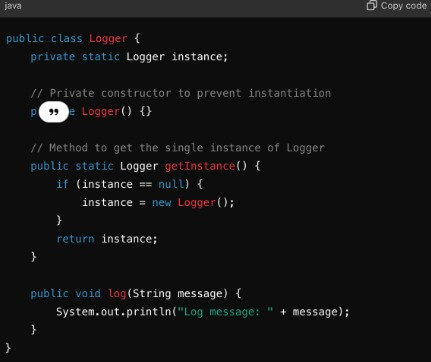In the realm of programming, recurring problems often arise that need efficient solutions. To address these issues, the concept of design patterns emerged. Design patterns are proven solutions to common problems in software design. For beginner IT engineers, understanding and applying design patterns can be a pivotal step in enhancing their skills and the quality of their code.
Design Patterns Definition.
Design patterns are well-documented solutions to common problems in software development. These solutions are not ready-to-use code but rather guidelines or blueprints that can be adapted to meet the specific needs of a project. Design patterns help create that is more maintainable, extensible, and efficient.
Categories of Design Patterns.
Design patterns fall into three main categories; creational, structural, and behavioral.
1. Creational Patterns.
These patterns deal with object creation mechanisms, aiming to create objects in a manner suitable for the situation. Examples;
- Singleton: Ensures a class has only one instance and provides a global point of access to it.
- Factory Method: Defines an interface for creating an object, but allows subclasses to alter the type of objects that will be created.
- Abstract Factory: Provides an interface for creating families of related or dependent objects without specifying their concrete classes.
2. Structural Patterns.
These patterns deal with object composition or the structure of classes.
- Adapter: Allows incompatible interfaces to work together by creating an adapter that translates one interface to another.
- Decorator: Adds responsibilities to objects dynamically without altering their code.
- Composite: Composes objects into tree structures to represent part-whole hierarchies.
3. Behavioral Patterns.
These patterns focus on communication between objects. These are the examples;
- Observer: Defines a one-to-many dependency between objects so that when one object changes state, all its dependents are notified and updated automatically.
- Strategy: Defines a family of algorithms, encapsulates each one, and makes them interchangeable.
- Command: Turns a request into a stand-alone object that contains all information about the request.
Benefits of Using Design Patterns.
1. Reusability.
Design patterns help create solutions that can be reused for similar problems in the future, reducing development time and increasing efficiency.
2. Better Maintenance.
Code that uses design patterns tends to be more structured and understandable, making it easier to maintain and debug.
3. Flexibility and Extensibility.
Design patterns provide ways to modify parts of the system without affecting other parts, making the system more flexible and easier to extend.
4. Standardization.
Using design patterns brings a level of standardization to software development, which facilitates team communication and documentation.
Example of Design Pattern Implementation.
Let’s look at a simple example of using a design pattern in code. Suppose we want to create a logging system that ensures only one instance is used throughout the application (Singleton pattern).

By using the Singleton pattern, we ensure that only one instance of the ‘Logger’ class is used throughout the application, accessible globally.
How to Master a Design Pattern?
1. Learn and practice.
Read books and articles on design patterns, such as “Design Patterns: Elements of Reusable Object-Oriented Software” by the Gang of Four. Practice by creating small projects that implement various patterns.
2. Analyze Existing Code.
Review code from existing projects and try to identify the patterns used. This helps in understanding how patterns are applied in real-world scenarios.
3. Use When Needed.
Don’t force the use of design patterns if nor necessary. Choose the pattern that best fits the problem at hand.
4. Collaborate.
Discuss with teammates and mentors to gain different perspectives and learn from their experiences.
Conclusion.
Design patterns are highly useful tools in software development, but like any other tools, they must be used wisely and in the appropriate context. It is crucial for engineers, especially those who are beginners, to understand when and how to use design patterns and to recognize the potential drawbacks and risks involved. With the right approach, design patterns can significantly enhance the quality and efficiency of software development, but improper use can lead to added complexity and additional problems.
Design patterns are essential tools in software development that help IT engineers create more efficient, maintainable, and flexible solutions. By understanding and applying design patterns, beginner IT engineers can improve their code quality and be better prepared to tackle challenges in software development projects. Keep learning and practicing to master design patterns, as they are a value investment in your career as a software developer.






